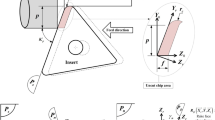Abstract
In this work the cutting tool temperature distribution that develops during turning of hardened cold-work tool steel is modeled on the basis of experimental data. The data obtained from a series of thermocouples, placed on a PCBN insert, into an anvil, and into a toolholder, were used as the input for the model. An inverse problem was solved, where the heat fluxes were computed. The temperature distribution was modeled for the case of new tools, as well as for the case of its development in the course of a tool wear. The reconstructed temperature distributions were in good agreement with the measured data. The heat flux through rake face was found to be reducing with the decrease of thermal conductivity of the tool material.
Similar content being viewed by others
References
Davies, M.A., Ueda, T., M’saoubi, R., et al., On the measurement of temperature in material removal processes, CIRP Annals–Manuf. Tech., 2007, vol. 56, pp. 581–604.
Armendia, M., Garay, A., Villar, A., et al., High bandwidth temperature measurement in interrupted cutting of difficult to machine materials, Ibid., 2010, vol. 59, pp. 97–100.
Komanduri, R. and Hou, Z.B., A review of the experimental techniques for the measurement of heat and temperatures generated in some manufacturing processes and tribology, Tribol. Int., 2001, vol. 34, pp. 653–682.
Zhou, F., Wang, X., Hu, Y., and Ling, L, Modeling temperature of non-equidistant primary shear zone in metal cutting, Int. J. Therm. Sci., 2013, vol. 73, pp. 38–45.
Karpat, Y. and Özel, T, Analytical and thermal modelling of high-speed machining with chamfered tools, J. Manuf. Sci. Eng., 2008, vol. 130, no. 1, pp. 0110011–01100115.
Yen, Y.-C., Jain, A., and Altan, T., A finite element analysis of orthogonal machining using different tool edge geometries, J. Mater. Process. Tech., 2004, vol. 146, no. 1, pp. 72–81.
Özel, T. and Altan, T, Process simulation using finite element method–prediction of cutting forces, tool stresses, and temperatures in high-speed flat end milling, Int. J. Mach. Tools Manuf., 2000, vol. 40, no. 5, pp. 713–738.
M’Saoubi, R. and Chandrasekaran, H, Experimental study and modeling of tool temperature distribution in orthogonal cutting of AISI 316L and AISI 3115 steels, Int. J. Adv. Manuf. Tech., 2011, vol. 56, nos. 9–12, pp. 865–877.
Marinov, V.R, Hybrid analytical-numerical solution for the shear angle in orthogonal metal cutting. Part I: Theoretical foundation, Int. J. Mech. Sci., 2001, vol. 43, no. 2, pp. 399–414.
Tay, A.A.O. and Lee, K.H, Calculation of temperature distributions in machining using a hybrid finite-element-boundary-element method, J. Mater. Process.Tech., 1992, vol. 29, nos. 1–3, pp. 47–62.
Yvonnet, J., Umbrello, D., Chinesta, F., and Micari, F., A simple inverse procedure to determine heat flux on the tool in orthogonal cutting, Int. J. Mach. Tool. Manuf., 2006, vol. 46, pp. 820–827.
Norouzifard, V. and Hamedi, M., A three-dimensional heat conduction inverse procedure to investigate tool–chip thermal interaction in machining process, Int. J. Adv. Manuf. Tech., 2014, vol. 74, pp. 1637–1648.
Carvalho, S.R, Lima e Silva, S.M.M., Machado, A.R., et al., Temperature determination at the chip–tool interface using an inverse thermal model considering the tool and tool holder, J. Mater. Process. Tech., 2006, vol. 179, pp. 97–104.
Brito, R.F., Carvalho, S.R., Lima e Silva, S.M.M., et al., Experimental investigation of thermal aspects in a cutting tool using COMSOL and inverse problem, Appl. Therm. Eng., 2015, vol. 86, pp. 60–68.
Beck, J.V., Blackwell, B., St Clair, C.R., et al. Inverse heat conduction. Ill-posed problem, New York: A Wiley-Interscience publication, 1985.
Tikhonov, A.N. and Arsenin, V.Y., Solution of Ill-posed Problems, Washington DC: Winston & Sons, 1977.
Kryzhanivskyy, V., Bushlya, V., Gutnichenko, O., Petrusha, I.A., and Ståhl, J.-E., Modelling and experimental investigation of cutting temperature when rough turning hardened tool steel with PCBN tools, Procedia CIRP, 2015, vol. 31, pp. 489–495.
Bushlya, V.M., Gutnichenko, O.A., Zhou, J.M., Ståhl, J.-E., Gunnarsson, S., et al., Tool wear and tool life of PCBN,binderless cBN and wBN–cBN tools in continuous finish hard turning of cold work tool steel, J. Superhard Mater., 2014, vol. 36, no. 1, pp. 49–60.
Ståhl, J.-E., Metal cutting: theories and models, Fagersta, Sweden: SECO Tools, 2012.
Orlande, H.R.B., Fudym, O., Maillet, D., and Cotta, R.M., Thermal measurements and inverse techniques, New York: CRC Press, Taylor & Francis Group, 2011.
Avriel, M., Nonlinear Programming: Analysis and Methods, New-York: Dover Publishing, 2003.
Kagnaya, T., Lazard, M., Lambert, L., et al., Temperature evolution in a WC–6%Co cutting tool during turning machining: experiment and finite element simulations, WSEAS Trans. HAMT, 2011, vol. 6, pp. 71–80.
Shaw, M.C., Metal cutting principles, Oxford: Oxford University Press, 2004.
M’Saoubi, R., Lebrun, J.L., and Changeux, B., A new method for cutting tool temperature measurement using CCD-infrared technique: influence of tool and coating, Mach Sci Technol., 1998, vol. 2, pp. 369–382.
Bushlya, V., Gutnichenko, O., Zhou, J., et al., Effects of cutting speed when turning age hardened Inconel 718 with PCBN tools of binderless and low-cBN grades, Mach. Sci. Technol., 2013, vol. 17, no. 4, pp. 497–523.
Author information
Authors and Affiliations
Corresponding author
Additional information
The text was submitted by the authors in English.
About this article
Cite this article
Kryzhanivskyy, V., Bushlya, V., Gutnichenko, O. et al. Influence of tool material and tool wear on tool temperature in hard turning reconstructed via inverse problem solution. J. Superhard Mater. 39, 192–202 (2017). https://doi.org/10.3103/S1063457617030078
Received:
Published:
Issue Date:
DOI: https://doi.org/10.3103/S1063457617030078



